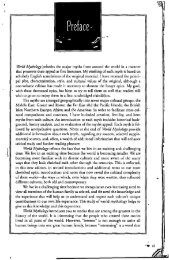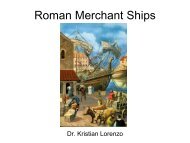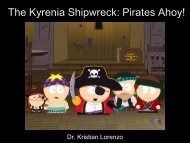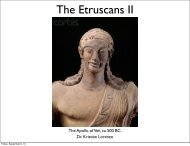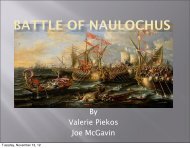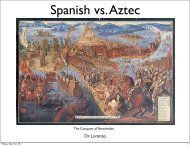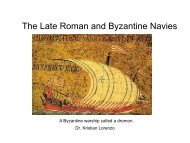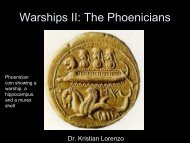9-7-2012-CapeGelidonya-Uluburun-Greek-Pres-5 - Eastern ...
9-7-2012-CapeGelidonya-Uluburun-Greek-Pres-5 - Eastern ...
9-7-2012-CapeGelidonya-Uluburun-Greek-Pres-5 - Eastern ...
You also want an ePaper? Increase the reach of your titles
YUMPU automatically turns print PDFs into web optimized ePapers that Google loves.
A Tale of Three Ships:<br />
Bronze Age Shipwrecks<br />
Thera/Akrotiri, Ship procession Fresco, ca. 1600 B.C.<br />
Dr. Kristian L. Lorenzo
A Tale of Three Ships:<br />
Bronze Age Shipwrecks<br />
Thera/Akrotiri, detail of Ship Procession Fresco, ca. 1600 B.C.
Dates, Dates, Dates…<br />
• Absolute Dates: e.g. 1300 B.C.; 266 B.C.<br />
• Centuries: e.g. 3 rd B.C.; 4 th c. A.D.<br />
B.C. = Before Christ;<br />
A.D. = Anno Domino = Latin for “In the year<br />
of our lord” so after Christ<br />
• Periods: e.g. Late Bronze Age; Hellenistic Period
For this Class…<br />
• The Bronze Age: ca. 1800-1100 B.C.<br />
• The Archaic Period: ca. 900-480 B.C.<br />
• The Classical Period: ca. 479-323 B.C.<br />
• The Early Hellenistic Period: ca. 323-200 B.C.<br />
• The Hellenistic Period: ca. 323-29 B.C.
Ships: The Basic Elements
A Tale of Three Ships: Today’s Topics<br />
The Grand Congloué Ship<br />
George Bass<br />
The Cape Gelidonya Ship<br />
The <strong>Uluburun</strong> Ship
In 1952 underwater shipwrecks<br />
gain Academic attention.<br />
Non-diver archaeologist Fernand<br />
Benoit and non-archaeologist divers<br />
including Jacque Cousteau<br />
excavate 2 cargo ships.<br />
The Grand Congloué Ship
The Grand Congloué Ship<br />
Amphorae: ceramic vessels for the storage and transport of<br />
commodities, trade items, gifts, etc
George Bass<br />
Founder of scientific maritime Archaeology<br />
Founder of scientific nautical archaeology<br />
An Archaeologist First<br />
A Diver Second<br />
Directed the excavation of the Cape Gelidonya shipwreck<br />
Founder of the Institute of Nautical Archaeology –<br />
http://inadiscover.com/
Excavated by: George Bass<br />
and the University of<br />
Pennsylvania<br />
Location: off Cape<br />
Gelidonya, Turkey<br />
Date: ca. 1200 B.C.<br />
Depth: ca. 81 ft<br />
Excavation: 1960<br />
Type: Merchant vessel, ca.<br />
40 ft long<br />
The Cape Gelidonya Ship
The Cape Gelidonya Ship<br />
• Both the director, George Bass, and his excavation<br />
team are all archaeologists first and divers second.
The Cape Gelidonya Ship: Basic Methods Learned<br />
• Every feature of the shipwreck site is recorded in situ<br />
with drawings (plans) and photography
The Cape Gelidonya Ship: Basic Methods Learned
The Cape Gelidonya Ship: Basic Methods Learned<br />
The map (plan) of every archaeological site is recorded in 2 planes:<br />
horizontal and vertical
The Cape Gelidonya Ship: Basic Methods Learned<br />
The airlift is normally the pick and shovel of maritime archaeology
The Cape Gelidonya Ship: Primary Cargo<br />
40 copper Ox hide ingots with 27 from Cyprus (ingot: a mass of metal cast in a form<br />
convenient for shaping, re-melting or refining)
The Cape Gelidonya Ship: Secondary Cargo<br />
Several hundred broken bronze tools, including axes, adzes, picks, hoes, etc
The Cape Gelidonya Ship: What’s so<br />
Important?<br />
Offered a new scientific model for how underwater<br />
excavations should be conducted<br />
Based upon analysis of the ship and its cargo:<br />
It was Near <strong>Eastern</strong> in origin, perhaps Syrian<br />
It was crewed by Syrians and/or Phoenicians<br />
Challenged the notion that mainly Minoans and/or<br />
Mycenaeans were traders and merchants ca. 1200 B.C.
Excavated by: Institute of<br />
Nautical Archaeology<br />
Location: near <strong>Uluburun</strong><br />
(“Grand Promontory”) Turkey<br />
Date: late 14 th century B.C.<br />
Depth: 135-200 ft<br />
Excavation: 1984-1994<br />
Type: Merchant vessel,<br />
ca. 49 ft<br />
The <strong>Uluburun</strong> Ship<br />
Italy<br />
Greece<br />
Turkey
The <strong>Uluburun</strong> Ship<br />
Big Finds: Ship made from Lebanese Cedar planks which grow in<br />
Lebanon, southern Turkey and Cyprus. A modern replica.
The <strong>Uluburun</strong> Ship:<br />
“Shell-First” Mortise-and-Tenon Construction<br />
• Wood Planks<br />
• Oak Pegs<br />
• Mortise holes<br />
• Tenons
Big Finds: Cypriot Copper “Ox-Hide”<br />
Ingots
Big Finds:<br />
Cypriot/Near<br />
<strong>Eastern</strong> Stone<br />
Anchors
The <strong>Uluburun</strong> Ship: Small Finds<br />
Cypriot, Near <strong>Eastern</strong> and Mycenaean Ceramic Vessels:
Jewelry from the area of the Black Sea
Ivory: Hippopotamus Teeth from Egypt
Weapons from the area of Albania,<br />
Bulgaria, etc.
Near <strong>Eastern</strong>, Mycenaean and Italic<br />
Swords
Scarab: Nefertiti<br />
This scarab provides a “Smoking-Gun” for dating purposes allowing a terminuspost-quem<br />
(Latin for “a point after which”) for when the ship sank. Nefertiti<br />
disappeared from historical records after the 12th year of her husband Akhenaton’s<br />
reign ca. 1340 B.C.
The <strong>Uluburun</strong> Ship<br />
A computer model showing the <strong>Uluburun</strong> ship fully loaded.
The <strong>Uluburun</strong> Ship: What’s so Important?<br />
Several widely dispersed cultures represented = Great<br />
evidence for international trade/elite gift giving<br />
- Baltic Region, Black Sea area, Syro-Palestinian coast,<br />
Egypt, Mycenaean <strong>Greek</strong> mainland, Italy/Sicily
The <strong>Uluburun</strong> Ship: What’s so<br />
Important?<br />
Oldest intact shipwreck studied by archaeologists<br />
The maritime equivalent to King Tutankhamun’s<br />
tomb – it sank around the time of his death or after
The <strong>Uluburun</strong> Ship: What’s so Important?<br />
Cargo is well-preserved and able to shed “material”<br />
light on objects seen only in Egyptian tomb<br />
paintings or mentioned in Egyptian royal<br />
diplomatic correspondence





